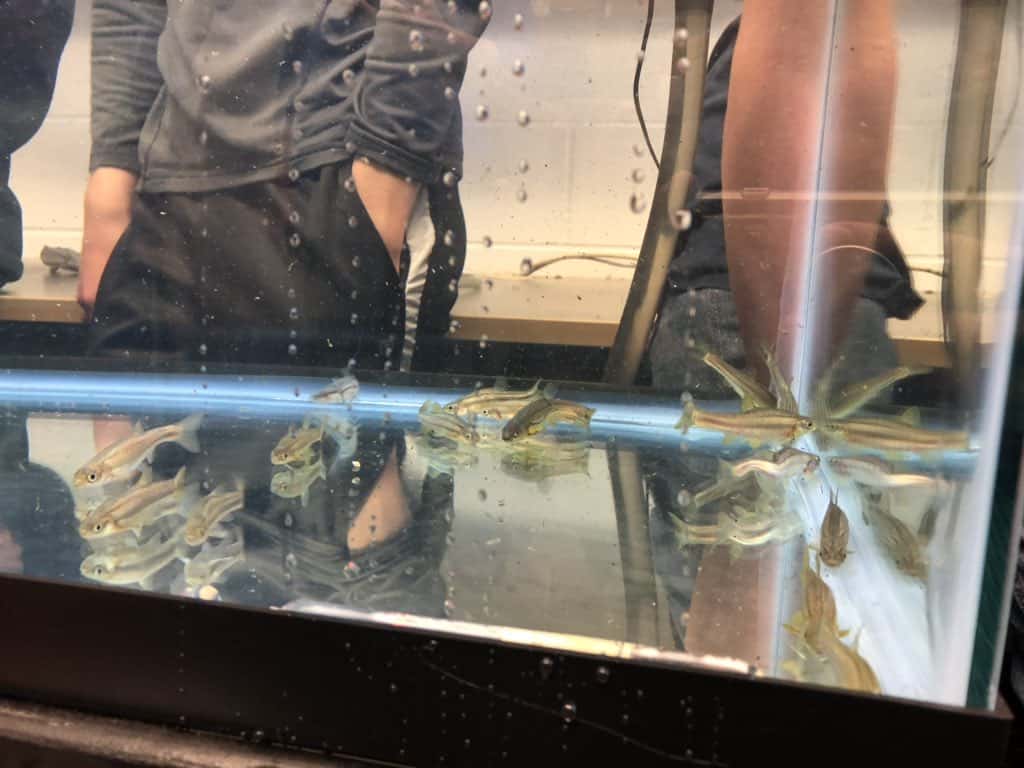In September 2013, 15 inches of rain fell over the course of a week, overflowing the St. Vrain Creek, displacing hundreds of residents in surrounding communities, and damaging countless property and infrastructure. Seven years later, through a partnership with Ocean First Institute, Colorado Parks and Wildlife, and Boulder County Parks and Open Space, St. Vrain high school students are playing a part in continued efforts to rebuild the community.
As a result of the 2013 Colorado Front Range Flood, the native Northern Redbelly Dace was adversely affected by overflowing sediment that altered its habitat in local ponds. The fish, classified as a Tier 1 Species of Greatest Conservation Need, are considered endangered in Colorado because of low population numbers. By pairing students with biologists, an innovative recovery project aims to raise and successfully breed 100 redbelly dace, the offspring from which will be used to reintroduce the species locally.
To kick off the project, members of partnering organizations visited the John W. Mumma Native Aquatic Species Restoration Facility in Alamosa, recognizing the opportunity to teach students about conservation and environmental biology in a hands-on environment while helping to restore the population of a fish indigenous to the St. Vrain. Both Lyons Middle Senior High School and the Innovation Center of St. Vrain Valley Schools created student teams to work on the project, with plans to collaborate through an online Schoology course.
“We thought that this would be a great opportunity to make a connection with the Innovation Center and have our students work on a project together,” said Colleen Ford, Assistant Principal at Lyons Middle Senior. “The goal is to help our students understand how science relates to their real world and their environment.”
At Lyons, students in the Science and Leadership program focused on water quality tests, feeding, and research to help determine the best environment for raising the fish and getting them to spawn. Through the Innovation Center’s Applied Robotics Conservation through Technology class, students focused on learning how technology can be applied to monitoring, regulating, and rehabilitating habitats.
In early March, Colorado Parks and Wildlife delivered 100 redbelly dace from Alamosa — 50 to Lyons Middle Senior, and 50 to the Innovation Center. The project was off to an exciting start when the coronavirus pandemic forced school buildings to close in mid-March and students transitioned to remote learning. Dr. Mikki McComb-Kobza, Executive Director of Ocean First and project mentor for the students, set up multiple tanks in her basement and relocated the 100 fish to her home.
“Students were able to stay engaged with the fish because Dr. McComb-Kobza set up a webcam,” said Nyko de Peyer, technology education teacher at the Innovation Center. “They continued to work on projects focused on conservation and communicated what they were learning with technology.
Through WebEX meetings, McComb-Kobza provided updates on the fish and their reproduction. She also excitedly shared the updates on social media.
In late May, the redbelly dace began to lay eggs, offering hope for the continuation of the project. Though the project looks different than originally planned, the fish spawned seven times this summer, an encouraging sign for conservation efforts.
The redevelopment of a pond at Pella Crossing by Hygiene has also faced unexpected challenges, so the fish will be released into a compatible habitat on a private property in Lyons on August 26. Once moved to their new home, the students will help manage the pond to encourage a successful transplant. If the fry successfully develop to adulthood, they can be reintroduced to the St. Vrain River. If successfully reintroduced to the wild locally, Colorado Parks and Wildlife can attempt additional transfers throughout the state.
Ford hopes to continue to connect the project to other science classes at Lyons, including a ninth grade biology class learning about microplastics, a tenth grade chemistry class checking water chemistry in local streams, and an AP environmental science class. Once released into the wild, the Innovation Center students can utilize innovative technologies to look at the parameters of the habitat, like using underwater cameras to monitor and regulate the environment.
“The overall goal is to continue to increase the population of redbelly dace to the point where they can thrive in one of their former natural habitats,” says de Peyer. “They are also an indicator species, so they can help tell if the watershed is being polluted, or is unhealthy. Reintroducing this species is important in helping inform what is going on in their ecosystems.”

